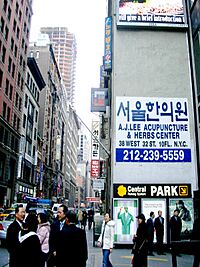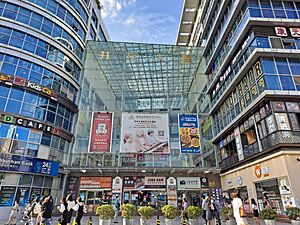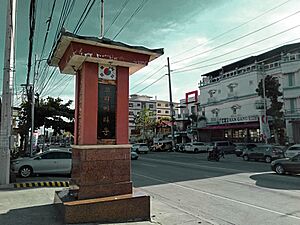Koreatown facts for kids
| Koreatown | |
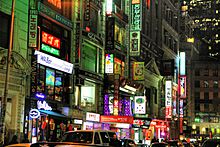
Koreatowns, like this one on 32nd Street in Manhattan, show where Koreans live and share their culture around the world.
|
|
Quick facts for kids Korean name |
|
|---|---|
| Hangul |
코리아타운
|
| Revised Romanization | Koriataun |
| McCune–Reischauer | K'oriat'aun |
A Koreatown (Korean: 코리아타운) is a special neighborhood in a city or large area outside of Korea. It's a place where many Korean people live, work, and keep their culture alive. You might also hear it called a Little Korea or Little Seoul.
Contents
- The Story of Koreatowns
- What Makes a Koreatown Special?
- Where Are Koreatowns Found?
- Koreans Around the World
- Koreatowns in the Americas
- Argentina
- Brazil
- Chile
- Mexico
- Canada
- United States
- Koreatowns in East Asia
- Koreatowns in Southeast Asia
- Koreatowns in Oceania
The Story of Koreatowns
Koreatowns are fairly new. They started appearing in the mid-1860s. Before that, most Koreans stayed in Korea. Large groups of Koreans first moved to the Russian Far East and Northeast China. Their descendants now live in places like China and Central Asia.
Koreatowns in Western countries, like the United States and Canada, came much later. For example, Los Angeles Koreatown was officially recognized in 2008. Many Koreatowns are not official. You can spot them by seeing many Korean stores with signs in Korean.
Sometimes, these neighborhoods faced challenges. In the 1992 Los Angeles riots, many Korean businesses were targeted. In Philadelphia, some people didn't want Koreatowns to be officially recognized. This is why many Koreatowns in Western countries don't have the same official status as some Chinatowns.
Today, many Koreatowns are found in suburban areas, not just big cities. This is because Korean families often look for safer neighborhoods and better schools. Education is very important to them. For example, Philadelphia's Koreatowns are now in suburban places like Cheltenham, Pennsylvania.
What Makes a Koreatown Special?
Many things make a Koreatown unique and easy to spot.
Korean Signs and Language
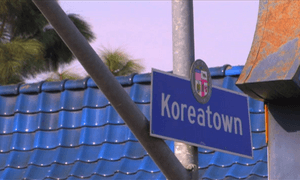
In Koreatowns, you'll often see signs in the Korean language and its writing system, Hangul. Sometimes, these signs are even on official highway signs! In English, you might see "Koreatown," "Little Korea," or "Korea Way."
About 80 million people around the world speak Korean. It's the official language of South Korea and North Korea. For a long time, Korean was written using adapted Chinese characters. But in the 15th century, King Sejong the Great created Hangul. It's a simpler writing system that became widely used in the 20th century.
Delicious Korean Food

Koreatowns are famous for their Korean cuisine. This is a big difference from other Asian neighborhoods like Chinatowns or Little Saigons. Korean food has changed a lot over hundreds of years. It started from old farming and nomadic traditions.
Korean meals usually include rice, vegetables, and meat. They are known for many small side dishes called banchan. Kimchi, a spicy fermented cabbage, is often served with every meal. Common ingredients include sesame oil, soy sauce, garlic, ginger, and pepper flakes.
Where Are Koreatowns Found?
Koreans Around the World
| Total population | |
|---|---|
| 7,493,587 (2019) | |
| Regions with significant populations | |
| 2,546,982 | |
| 2,461,386 | |
| 824,977 | |
| 241,750 | |
| 177,270 | |
| 172,684 | |
| 169,933 | |
| 167,331 | |
| 109,923 | |
| 85,125 | |
| 48,281 | |
| 44,864 | |
| 40,770 | |
| 38,114 | |
| 29,167 | |
| 23,063 | |
| 22,774 | |
| 21,406 | |
| 20,861 | |
| 20,200 | |
| 18,515 | |
| 13,070 | |
| 12,721 | |
| 11,969 | |
| 11,897 | |
| 11,273 | |
| 10,930 | |
| 9,581 | |
| 8,601 | |
| 7,667 | |
| Languages | |
| Korean, various local languages | |
| Related ethnic groups | |
| Korean people | |
Many Koreatowns are places where a large number of Koreans live. Almost four out of five Koreans who live outside Korea are in China, the United States, and Japan. Other countries with many Korean residents include Australia, Canada, Kazakhstan, New Zealand, and Uzbekistan. As of 2010, about 5.3 million Koreans lived outside their home country.
Koreatowns in the Americas
Argentina
Buenos Aires has a 'Barrio Coreano' (Korean Neighborhood) in Flores. You'll find Korean restaurants, beauty salons, a Korean school, and churches there. More than 22,000 Koreans live in Argentina, mostly in Buenos Aires.
Brazil
Bom Retiro in São Paulo has become a Koreatown. It's a great place for Korean food, from traditional dishes like bibimbap to modern cafes. You can also find Korean markets with special ingredients. Korean and Brazilian cultures mix here, with signs in both languages. The community holds cultural festivals and K-pop concerts. The city of São Paulo might officially name Bom Retiro as 'Koreatown'.
Chile
Most Koreans in Chile live in Patronato in Santiago. About 3,000 Koreans live in Chile. The Korean community is very organized. They hold events like soccer tournaments and Korean festivals.
Mexico

Mexico City has a large Korean population, especially around Zona Rosa. This area was nicknamed “Pequeño Seul” (Little Seoul) in the 1990s.
Canada
Toronto, Ontario
Toronto officially named an area on Bloor Street as Koreatown in 2004. This area has Korean grocery stores, hairdressers, karaoke bars, and many restaurants. It's known for its Korean fashion shops and herbalists. Toronto's Koreatown also hosts the Spring Dano Festival. While many Koreans work here, fewer live in this specific area now.
There's also an unofficial "Koreatown North" along Yonge Street in North York. This area has a mix of Korean, Persian, and Chinese businesses.
Vancouver, British Columbia
The largest group of Koreans in British Columbia is near Lougheed Town Centre in Burnaby and Coquitlam. Along North Road, you'll find big Korean supermarkets like H Mart, hair salons, restaurants, and other businesses. More Koreans are moving to other parts of Metro Vancouver, leading to new Korean businesses opening there too.
United States
The first large group of Korean immigrants came to America between 1901 and 1905. Most of them went to Hawaii to work on sugar plantations. Early Korean settlements were in San Francisco, Dinuba, and Riverside, California.
Atlanta, Georgia
Atlanta has a large Korean population, with about 94,000 people of Korean descent in 2010. Atlanta's Koreatown is mainly around Duluth, Georgia, and Buford Highway. This area has many Korean shops and services. Atlanta also has Korean-language TV stations and a Korean newspaper.
Aurora, Colorado
About 2,000 Korean immigrants live in Aurora. A part of Havana Street has many Korean businesses. The city council once thought about making it an official Koreatown.
Baltimore, Maryland
A small part of Charles Village is sometimes called Koreatown. It has several Korean restaurants. Suburban Ellicott City, Maryland and Catonsville, Maryland also have growing Koreatowns along Route 40.
Boston, Massachusetts
Boston's Koreatown is in Allston Village. It includes parts of Cambridge Street and Brighton, Harvard, and Commonwealth Avenue. This area has a growing number of Korean homes and businesses.
Chicago, Illinois
Chicago's Albany Park neighborhood has been known as "Koreatown" since the 1980s. Many Korean shops are on Lawrence Avenue, which is officially called "Seoul Drive." Even though some Koreans have moved to the suburbs, the area still feels very Korean. It hosts a Korean festival every year and has Korean TV and radio stations.
Columbus, Ohio
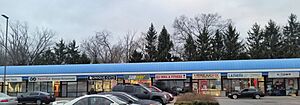
Koreatown in Northwest Columbus is near Bethel and Henderson Roads. Here, you'll find Korean grocery stores, churches, and restaurants.
Dallas, Texas
Dallas has the largest Korean-American community in Texas. In 2023, Texas officially named an area in Northwest Dallas as a Koreatown. This area, called the Asian Trade District, has many Korean-owned businesses.
Another Koreatown is in Carrollton, Texas. Locals call it "New Koreatown" because it grew after the Hmart supermarket opened there. Many restaurants and shops have opened around Hmart.
Honolulu, Hawaii
Korean businesses gather on Keeaumoku Street, which is nicknamed "Koreamoku." In 2016, it became an official Koreatown.
Houston, Texas
Spring Branch, Houston is considered to have the largest Koreatown in the Houston area.
Orange County, California
Koreatown in Garden Grove, Orange County, California, is on Garden Grove Boulevard. It's also called Little Seoul. The Korean population in Orange County has more than doubled between 1990 and 2010.
Los Angeles, California
The Greater Los Angeles Area has the largest number of Koreans outside of Korea. Koreatown is an official district with many Korean residents and businesses. Koreans started moving here in the late 1960s. After the 1992 riots, Koreatown grew even more.
New York Metropolitan Area
The New York area has the second-largest Korean population outside Korea. About 100,000 Korean Americans in New York City live there, mostly in Queens. Bergen County, New Jersey, also has many Korean residents.
Manhattan
In Midtown Manhattan, Koreatown is near the Empire State Building. The main part is on 32nd Street, called "Korea Way." It has many Korean restaurants, bakeries, grocery stores, and even noraebang bars. Many businesses are open 24/7.
Long Island

The Long Island Koreatown is one of the biggest and fastest-growing Korean areas. It started in Flushing and spread eastward into other Queens neighborhoods and Nassau County. This area has many Korean restaurants, markets, and businesses.
Bergen County
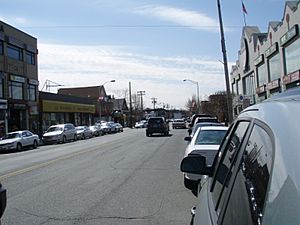
Koreans began moving to Eastern Bergen County, New Jersey in the 1980s. By 2010, Bergen County had the highest percentage of Koreans of any county in the U.S. The main Koreatowns are on Broad Avenue in Palisades Park and around Main Street in Fort Lee. These areas are popular for Korean food and desserts. Big Korean companies like Samsung also have offices here.
Oakland, California
Oakland's Koreatown is on Telegraph Avenue. It has about 150 Korean-owned businesses. This area is called "Koreatown-Northgate" and has an annual cultural festival. Many Koreans moved here after the Los Angeles Riots in 1992.
Philadelphia, Pennsylvania

Philadelphia's first Koreatown was in the Olney section. The Korean community has grown north into Cheltenham. Upper Darby Township also has many Korean Americans. A new Korean area is growing in Cherry Hill, New Jersey.
Washington, D.C.
Koreatown in Annandale, Virginia, is a hub for the many Koreans living in the Washington-Baltimore area. It has over 1,000 Korean-owned businesses, including restaurants, banks, and hair salons.
Koreatowns in East Asia
Mainland China
China has the largest Korean population outside Korea, with about 2.3 million people. Many are descendants of Korean immigrants who are now Chinese citizens. The Yanbian Korean Autonomous Prefecture has 854,000 ethnic Koreans.
Beijing
About 200,000 Koreans live in Beijing. There are two main Koreatowns:
- Wangjing in Chaoyang district: This is the bigger Koreatown with many Korean companies. It has restaurants, spas, bookstores, and Korean banks.
- Wudaokou in Haidian district: This area is near many universities, so it has many Korean college students.
Qingdao
About 182,000 Koreans live in Qingdao, Shandong Province.
Shenyang
Shenyang has a large Koreatown called Xita.
Shanghai
About 86,000 Koreans live in Shanghai. The Longbai area in the Minhang district has a Korean neighborhood.
Hong Kong
In 2011, there were 13,288 Koreans in Hong Kong. Kimberley Street in Tsim Sha Tsui is known as Korean Street or Little Korea. It has Korean restaurants and grocery stores.
Japan
During the time Korea under Japanese rule, about 2.4 million Koreans moved to Japan. Many left after the war, but some stayed. Today, Koreans are the third-largest ethnic minority in Japan.
Osaka
Ikuno Korea Town in Osaka is the largest in Japan, with over 58,000 Koreans. In Ikuno Ward, 16% of people are of Korean origin. Tsuruhashi is the biggest Koreatown here.
Tokyo
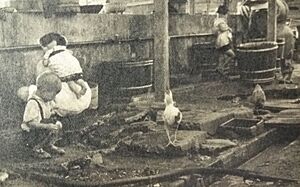
Tokyo had about 92,000 Koreans in 2022. Tokyo's Korean center is in Okubo, around Shin-Okubo Station in Shinjuku Ward. This Koreatown grew after World War II. It has many signs in hangul and businesses that serve both Koreans and Japanese visitors.
Shimonoseki
Green Mall in Shimonoseki, Yamaguchi is a Koreatown. It's sometimes called "Little Pusan."
Taiwan
A small Koreatown exists in Zhongxing Street in Yonghe District, New Taipei City.
Koreatowns in Southeast Asia
Indonesia
A new Koreatown is being built in north Jakarta Pulomas. It will be the first Koreatown built from scratch. About 40,000 Koreans live in Indonesia.
Malaysia
Kuala Lumpur
More than 20,000 Koreans live in Kuala Lumpur. Sri Hartamas is a neighborhood with many Korean families. It has Korean supermarkets, restaurants, and hair salons. Malaysia's first official Korean school was set up in 1974.
Philippines
The most famous Koreatown in Metro Manila is in Makati's Barangay Poblacion. In Angeles, Pampanga, the Anunas area has a Koreatown with many Korean businesses. The mayor of Manila is also discussing creating a "Korea Town" in Malate.
Singapore
There are Koreatowns in the Upper Bukit Timah and Tanjong Pagar areas of Singapore. Many Koreans live in these areas, so there are many Korean restaurants and shops. As of 2023, about 21,203 Koreans lived in Singapore.
Thailand
There is one Koreatown in Bangkok near Sukhumvit Soi 12 and another in Phuket. These areas have both North Korean refugees and South Korean residents.
Vietnam
Koreans in Vietnam include migrants and Vietnamese citizens of Korean background. After the Vietnam War, more South Koreans came to Vietnam for business or to find wives. As of 2011, about 80,000 Koreans lived in Vietnam.
Koreatowns in Oceania
Australia and New Zealand
Sydney
Sydney's Koreatown is in the Sydney central business district, around Pitt Street and Liverpool Street. It has many Korean restaurants, grocery stores, and bars. Other Korean areas are in Eastwood, Strathfield railway station, and Campsie.
Melbourne
Melbourne's Koreatown is mainly around La Trobe Street and Victoria Street in North Melbourne.


